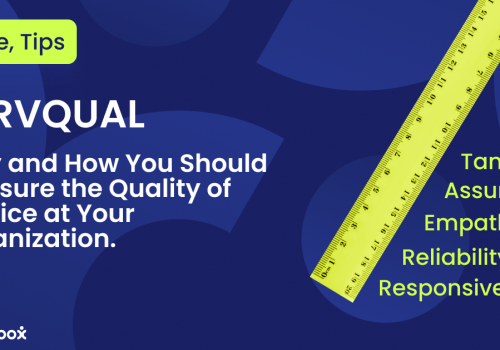Customer Support Workflows. All business environments can be busy and chaotic places where thousands of tasks need to be completed every day. There are usually several teams with their own goals and tasks, and every team also needs to align with the wider business goals. For most businesses, this wider goal will, of course, be to bring in more customers, keep existing customers, and generate more revenue. Without workflows, achieving these goals can be challenging and maybe even impossible.
Put simply, a workflow is a sequence of tasks that an organization completes to achieve an end goal. The purpose of workflows is to provide a structure that gives direction to employees and add more clarity to the operation. An effective workflow needs to be repeatable and easy to understand. To put it another way, workflows remove chance from your success – they set out a repeatable roadmap for getting to where you want to be. With this in mind, we’ve put together a list of 5 proven customer service workflows that will help boost efficiency in your call center. Let’s take a look.
5 Proven Workflows
1. Well Designed Web Forms
Web forms are a popular alternative to email when it comes to customer feedback, but not all companies get them right. Your goal with web forms should be to simplify the customer experience and make it as easy as possible for them to say what they want to say. Remember, your customers are busy people, and they are only contacting customer service out of necessity. They’re not doing it for fun, and they likely want the experience to be as quick and painless as possible.
If you decide to offer complaint web forms, then they must provide a different experience than other complaint channels. The most successful companies from a customer service standpoint provide various communication channels, each with their own distinct benefits. Or, to put it another way, your web form shouldn’t just be an email channel with a facelift. So, how do you design an effective feedback webform? Here are some tips:
- Use multiple forms – You can use a chatbot or simple questionnaire to find the correct form for your customers. Please don’t go down the route of only designing one web form and making it fit every customer problem. It will end up needlessly long and complicated.
- Use conditional fields – This is where customers are given questions based on how they answered previous questions. For example, if they have a problem with an order, then they will see a field for “tracking number” or “order number.” However, they won’t see this field if they haven’t yet placed an order and are complaining about something different, like marketing content.
When you design web forms like this, it not only makes it better for customers, but it also improves operational efficiency and employee experience. A well-designed web form workflow means that tickets can be easily categorized and get sent straight to the best agent for the job.
The next step is to automate the whole process so that tickets appear in the agent’s queues without any manual input. You can design the workflow so that specific keywords will trigger an automated action. For example, words like “advert,” “tv,” “Twitter” likely mean the complaint is about marketing. The webform can be sent straight to the marketing team or the customer support team’s marketing arm.
2. Connecting Support and Marketing
Your support workflows must include a step to notify the marketing team of any issues. For example, let’s say that you’re having an unexpected server issue and a core part of your SaaS software is no longer working. Not a great situation, but with support workflows, you can get it sorted. The outage will trigger the software engineering team to work on fixing the problem and lay out the process for what the customer service team should tell concerned customers.
However, the marketing team also needs to be involved. Some customers choose to complain on Twitter or Facebook, and the marketing team will be the first to notice this. If the team is unaware of what’s happening, there will be a delay in the response, and customers will become increasingly frustrated.
The perfect technical issue workflow could look like this:
Automated software detects an issue with the server > Task triggered for engineering team > Customer service team notified of the issue > marketing team notified of the issue > Engineering team provides an estimated resolution time for marketing and customer service teams > Engineering notifies the teams when the issue is fixed > Customer service sends out a communication to all affected customers.

3. Customer Onboarding
Customer onboarding is a critical process in any business. How well designing your customer onboarding process is can make or break the customer experience? A lousy onboarding process can leave customers feeling confused about the product and mean they take much longer to see its value. It can also make customers feel undervalued themselves – like your company just took their money and then faded into obscurity.
There are tons of tips on creating the perfect customer onboarding process, but that isn’t what we’re talking about here. First, you need to decide what your onboarding process will look like. Once you’ve done that, it’s time to create a workflow to execute the same steps each time. Remember, a vital part of improving customer experience is providing consistency. If you leave the onboarding process manual or try to just remember the sequence of tasks, you’ll inevitably find that errors happen. Some steps get missed, and as a result, some customers get a worse experience. Here’s an example of a customer onboarding workflow:
Customer signs up > Welcome Email > Product setup email > Feature call out email/Link to knowledge base > regular celebration emails (for example, usage statistics).
4. Content Marketing Workflows
While not strictly customer service, content marketing is intrinsically linked to the customer experience. When marketing content resonates well with customers, the sales team gets more calls, and the customer service team gets fewer complaints. Why? Because when marketing is done well, it’s because it has achieved two goals:
- It has accurately represented the product.
- It has attracted good-fit customers (customers who will most benefit from and enjoy the product).
If these two goals aren’t met, you can guarantee that the customer service team will start getting an influx of complaints. For example, if the marketing content exaggerates some of the product features or implies that the product would be perfect for X type of person when actually that isn’t the case, the calls come in. Customers who buy the product based on that material (they were convinced it was right for them!) become angry or confused. Some of them might believe they were tricked. This is why getting the marketing content right is so crucial. Here’s an example of a content marketing workflow:
- The idea for a new article is born.
- The writer has to write the content.
- The editor then checks it for errors and polishes it.
- The article is sent to the design team or digital marketer, so images, graphics, and infographics can be added.
- The marketing team optimizes the article for Google and publishes it to the site.
5. Responding to Common Questions
All new call center agents need to know how to correctly answer the common questions and even the less common ones. The best way to do this is to design a workflow that sets out all common answers and questions. You can leverage automation and knowledgebases so that agents are presented with the right suggestions based on the customer’s keywords.
The customer might ask about a particular product or software feature and even have technical questions about how it works. The common answers should either be designed to be broad and detailed (answer multiple questions at once) or specific. However, if they are specific, the agent must ask the customer more questions before sending the answer. Otherwise, it can look like the agent isn’t listening or is misunderstanding the problem.
Here’s an example of a broad response workflow:
Customer: Hey, how do I resize an image
> the system recognizes “image” and “resize” and gives the agent an answer:
Agent: If you want to resize an image in the email creation window, follow these steps (include steps). If you want to resize an image in the content creation tab, follow these steps.
Alternatively, the agent can first ask where the customer is trying to resize the image and provide one of the two answers (specific rather than broad).




















